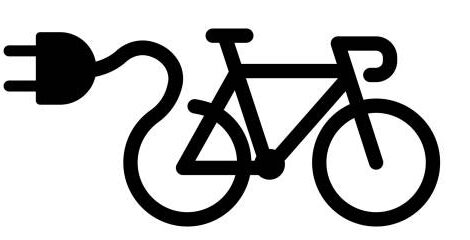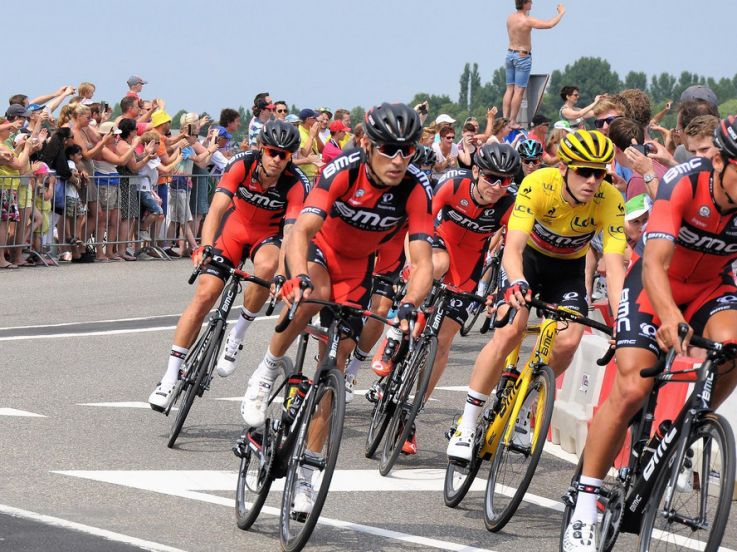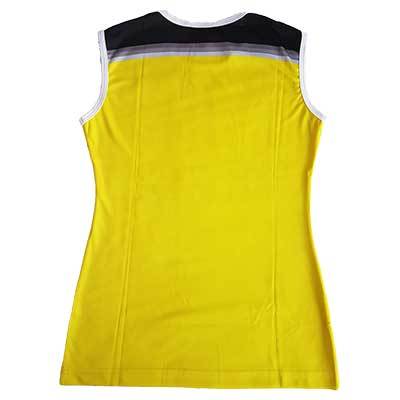The Iconic Yellow Jersey: A Symbol of Cycling Supremacy
The yellow jersey, known as the maillot jaune in French, stands as the most coveted prize in the Tour de France. Instantly recognizable, this bright yellow garment signifies leadership in the grueling three-week race. Its visual impact is undeniable, immediately signaling the cyclist who holds the overall lead. The history of this iconic jersey is as rich as the race itself. The tradition began in 1919, when the race organizers decided to distinguish the race leader with a unique, easy-to-spot jersey. This concept quickly took hold, embedding the yellow jersey as a central part of the Tour de France’s identity. It has become the ultimate symbol of cycling achievement and an object of aspiration for every professional rider participating in the race. The pursuit of the yellow jersey often defines the strategies and ambitions of entire teams throughout the event. Understanding the tour de france yellow jersey meaning involves appreciating its historical context as well as its profound impact on the sport. The meaning of the tour de france yellow jersey is more than just about a garment; it’s a symbol of excellence in cycling.
The jersey’s vibrant color was not chosen by chance. In the early days, the Tour de France was sponsored by a newspaper printed on yellow paper, and this became the inspiration for the leader’s distinctive jersey. This practical decision cemented the association between the yellow jersey and cycling’s grandest race. The visual prominence of the jersey ensures that the race leader is always easy to identify in the peloton. Its color contributes to the excitement of the race, providing visual focal points for both spectators at the roadside and millions of viewers following the tour globally. The tour de france yellow jersey meaning, it encapsulates the race’s heritage and the spirit of competition. The yellow jersey represents not just leadership but the accumulation of skill, determination, and strategy necessary to win it, making it a powerful symbol in professional cycling.
What Does the Maillot Jaune Represent in Cycling’s Grand Tour?
The maillot jaune, the French term for the yellow jersey, embodies a unique significance in the Tour de France. This iconic garment is not simply a prize for winning a single stage. Instead, it represents the pinnacle of consistent performance across all stages. The tour de france yellow jersey meaning is directly tied to the general classification. It is awarded to the cyclist who has accumulated the lowest total time from all the individual stages. This means the leader isn’t always the rider with the most stage wins. Instead, it’s the rider who has consistently performed well day after day. Each stage is part of a bigger picture. It’s not enough to just win some stages. A rider must demonstrate unwavering ability. The maillot jaune is a testament to stamina, tactical skill, and resilience. It showcases a cyclist’s capability to perform at their peak over an extended period.
The tour de france yellow jersey meaning can also be explained through its impact on the race. It’s about cumulative time, where every second counts. Time bonuses awarded at intermediate sprints and stage finishes, also play a crucial role. Penalties for infractions can also influence the overall standings. A cyclist can wear the yellow jersey for just one stage before it changes. This is all part of the competition’s allure. The general classification, is the main focus. It is the final determinant of who will win the Tour. The race is not just about spectacular finishes. It’s a competition of strength, planning and execution through all its stages. Therefore, the yellow jersey is a reflection of these combined attributes. This distinction highlights the unique challenges and rewards of the tour.
Understanding the tour de france yellow jersey meaning requires acknowledging its connection to the history of the race. It showcases the ability of a cyclist to consistently perform. It reflects the total race time. This adds an extra layer of intrigue. The quest for the yellow jersey is a strategic battle. It requires a balance of skill, endurance, and teamwork. This makes it the most coveted prize in professional cycling. The yellow jersey is a symbol of complete domination, not just winning single races. The battle to wear the yellow jersey and eventually win the Tour is the essence of the entire Grand Tour competition. This is what makes the tour de france yellow jersey meaning so prestigious.
How the Yellow Jersey Changes Hands During the Tour
The coveted tour de france yellow jersey meaning evolves daily throughout the race. Each stage presents a new opportunity to gain or lose precious seconds. The general classification dictates who wears the jersey. This classification is based on the cumulative time of each rider. The cyclist with the lowest overall time leads the race. This isn’t simply about winning individual stages. Consistency is key throughout the entire competition. The leader’s jersey can change multiple times during the race. It is a dynamic and exciting part of the Tour de France.>
The calculations for the general classification are crucial to understand. Each day, the times of all riders are added to their previous total. The rider with the lowest total time claims the yellow jersey. However, it’s not just about finishing times. Time bonuses awarded at certain points of a stage can also affect the standings. These bonuses can be gained for finishing near the front of a stage or at intermediate sprints. Conversely, time penalties can also influence the race. These penalties can be given for breaking rules. The tour de france yellow jersey meaning shifts with each adjustment in time. These small increments can significantly alter the race’s leader.
The battle for the tour de france yellow jersey meaning becomes a complex game of strategy. Teams meticulously plan their riders’ efforts to achieve it. They consider each rider’s strengths and weaknesses. They must balance the need to chase stage wins. They need to accumulate the fastest time, aiming for the overall race victory. The lead can change on even the smallest mistake. A crash, mechanical issue, or loss of focus can be costly. The yellow jersey is a prize won through sustained performance, and tactical prowess.
Beyond Victory: The Psychological Weight of the Yellow Jersey
The tour de france yellow jersey meaning extends far beyond its visual impact. Wearing it introduces a unique set of pressures. The race leader faces scrutiny from all angles. Every move is analyzed. Every decision is dissected. This intense focus can affect a rider’s performance. It is a weight that not every cyclist can bear. The yellow jersey is a symbol of leadership. It demands a particular mindset. Some riders thrive under pressure. They find added motivation in the spotlight. Others can crumble under the weight. The psychological aspect is a crucial component of the Tour de France. A rider’s mental fortitude becomes as important as physical strength. The tour de france yellow jersey meaning is also about mental resilience.
The impact of the maillot jaune extends to the entire team. The team’s strategy shifts drastically. Protecting the leader becomes the primary focus. Sacrifices are made to maintain the lead. Other riders dedicate themselves to supporting the yellow jersey wearer. The team must manage the additional stress. They must also manage the high expectations. Every stage is a defense of their position. The tour de france yellow jersey meaning goes beyond the individual. It’s about team cohesion. It is also about a collective strategy. The pressure is felt across the team. This shared experience can unite the team or create tension.
The psychological burden of the tour de france yellow jersey meaning can create a paradox. The jersey signifies success. It simultaneously creates immense stress. The rider and the team must work to handle it. The mental game becomes as important as the physical. How a rider handles pressure shapes their performance. The maillot jaune can be a catalyst for great achievements. It can also be a source of great disappointment. This psychological battle is a constant test in the Tour de France. The ability to stay focused under pressure is crucial. It is as important as physical ability. The tour de france yellow jersey meaning embodies the ultimate challenge.
The Legacy of Great Champions Who Donned the Golden Garment
The Tour de France yellow jersey meaning is deeply intertwined with the legends of cycling. Many champions have etched their names in history while wearing this prestigious garment. One such legend is Eddy Merckx, known as “The Cannibal.” His dominance in the late 1960s and early 1970s was unparalleled. Merckx won the Tour de France five times. He was also famous for winning stages and wearing the yellow jersey for many days. Another titan of the sport is Miguel Indurain. This Spanish cyclist was famous for his time-trialing prowess. He secured five consecutive Tour de France victories in the early 1990s. Indurain’s stoic demeanor while wearing the yellow jersey became an iconic image. These cyclists have showed the true essence of the tour de france yellow jersey meaning. His ability to maintain consistent performance was impressive. His reign showcased a masterclass in strategy. These iconic champions demonstrate the significance of the yellow jersey. They are an inspiration to those that participate in the tour.
Consider also the story of Bernard Hinault, “The Badger,” a true fighter. Hinault won the Tour de France five times with his aggressive style. His battles on the mountains while wearing the tour de france yellow jersey meaning, are still talked about today. He often attacked with no fear, making for some very exciting races. Another significant champion is Jacques Anquetil. He was the first to win the Tour de France five times. Anquetil was known for his tactical brilliance. He was also famous for his elegant style on the bike. His performances in the individual time trials are legendary. Each of these champions has added to the rich history of the race. Their stories illustrate the spirit of the yellow jersey.
More recently, riders like Chris Froome have also made their mark. Froome has won four Tour de France titles. He is known for his climbing ability and tactical racing. His period of dominance showed an example of planning. The yellow jersey was always his main goal. These examples highlight the intense dedication. It also highlights the great skill that is needed to win this race. These cyclists have all contributed to the rich legacy. They have increased the tour de france yellow jersey meaning. The yellow jersey is not just a piece of clothing. It is a symbol of the best in cycling. It represents the culmination of skill, strategy, and immense resilience.
The Materials and Design: Evolution of the Yellow Leader’s Jersey
The evolution of the Tour de France yellow jersey meaning is deeply connected to its material and design. Initially, the jersey was made of wool, a common fabric in the early 20th century. Wool was heavy, not very breathable, and absorbed sweat easily, making it uncomfortable for cyclists during long stages. As the sport evolved, so did the fabric technology. The shift from wool to synthetic materials, such as polyester and lycra, marked a significant change. These new fabrics were lighter, more aerodynamic, and significantly better at wicking moisture away from the skin, enhancing the riders’ performance. This transformation made the yellow jersey not only a symbol of leadership but also a testament to advancements in sportswear technology.
The design of the Tour de France yellow jersey has also changed subtly over the decades, but its iconic color has remained constant. The yellow hue was chosen by the race organizers, specifically Henri Desgrange, to honor the distinctive yellow paper of the L’Auto newspaper, the event’s initial sponsor. This association with the publication gave the jersey an instant identity and connection to the Tour’s origins. Over the years, the fit and cut of the jersey have been refined to enhance comfort and aerodynamics. Sponsors’ logos have become more prominent, while the yellow itself has been updated to more modern tones. However, the essence of the design — the bright yellow and the visual statement that comes with it — remains untouched, solidifying its place as one of the most recognizable garments in sports. The story of the jersey fabric itself tells the story of performance cycling as a whole.
The Tour de France yellow jersey meaning goes beyond its function as a piece of cycling apparel; it’s a symbol of ambition and achievement. The technological upgrades have allowed riders to perform better while carrying the weight of the lead. The iconic yellow color, a design consistent with the initial goal of its founders, makes the jersey easily recognizable and instantly associated with the pinnacle of cycling achievement. It’s an example of how a sport’s most prestigious reward evolves hand-in-hand with advancements in materials and design, while maintaining its symbolic weight and historical context. The legacy of the yellow jersey is woven into the fibers of cycling history.
How to Follow the Battle for the Yellow Jersey
Keeping track of the fight for the tour de france yellow jersey meaning can be an exciting part of enjoying the race. To stay informed, regularly check the stage results. These results are crucial because they determine the general classification. Understanding this classification is key. The general classification lists riders by their cumulative time. The cyclist with the lowest time wears the yellow jersey. Time bonuses and penalties can affect these standings. Time bonuses are awarded for winning stages or intermediate sprints. Penalties can be given for various infractions. Knowing these rules will enhance your understanding. Many platforms offer live updates. These include official Tour de France websites and apps. Cycling news websites also provide detailed reports. Social media can be great for real-time updates.
Use reliable apps to track the race. They often feature live timing. Many include detailed race maps. They also display riders’ positions. Explore official websites and sports news platforms. They provide in-depth analyses of each stage. They also offer insights on the tour de france yellow jersey meaning. Watching daily highlight shows is beneficial too. These recap the day’s most important moments. They explain the strategies used by teams. Online forums and social media groups can create a sense of community. Engage with other cycling fans and share your opinions. It is a great way to be a part of the excitement. Consider podcasts as a great resource. These often have cycling experts discussing the race. They dive deep into the tactics and the impact of the yellow jersey.
To fully appreciate the battle for the yellow jersey, be aware of each stage’s characteristics. Flat stages often favor sprinters. Mountain stages will suit climbers. Time trials test individual speed. These different stage types have a huge impact on the general classification standings. Understanding these dynamics will help predict potential yellow jersey contenders. The tour de france yellow jersey meaning is deeply tied to each day’s race and results. Being well informed allows you to fully experience the drama and excitement of the Tour de France. Enjoy the competition and the history being made.
The Yellow Jersey: More Than Just a Prize
The tour de france yellow jersey meaning transcends the simple concept of a garment or a prize. It is an emblem of cycling excellence. The yellow jersey embodies resilience and the very essence of the Tour de France. It represents the ultimate dream for every professional cyclist who participates in this legendary race. This coveted jersey is more than just a piece of fabric; it is a powerful symbol of leadership. It signifies the pinnacle of achievement in the sport. The journey to wear this iconic jersey is arduous, demanding immense physical and mental fortitude. It is a testament to a cyclist’s unwavering dedication and exceptional skill. To don the maillot jaune is to etch one’s name in cycling history. The weight of the jersey is felt with every pedal stroke, and the responsibility that comes with it is immense. The tour de france yellow jersey meaning is inextricably linked to the sacrifices and victories required to achieve this goal.
The tour de france yellow jersey meaning represents the culmination of weeks of relentless effort. It symbolizes the countless hours of training, the strategic planning, and the raw talent required to conquer the grueling stages of the Tour. It is a beacon of inspiration, a tangible representation of the unwavering commitment that defines the sport. It serves as a constant reminder that in this race, only the best can claim the ultimate prize. This competition is not just a series of individual rides, it is a calculated team effort. The jersey is a symbol of not just individual achievement but also team support. It also symbolizes the unyielding spirit of the sport of cycling. Cyclists push their limits daily for the chance to wear it. The yellow jersey stands as a beacon of what true champions can accomplish. This is the reason why the tour de france yellow jersey meaning is so deeply revered in the cycling world. The pursuit of the yellow jersey elevates ordinary athletes into legends.
It takes a combination of physical prowess, tactical brilliance, and mental fortitude to wear the maillot jaune. The yellow jersey represents a journey filled with challenges and triumphs. It is a symbol of consistent excellence. It also signifies a cyclist’s ability to perform at the highest level, day after day. To wear the yellow jersey is to shoulder the weight of history. It is also about handling the pressure of the competition and the adulation of the fans. The tour de france yellow jersey meaning is not just about being the fastest; it is about the embodiment of resilience, and the spirit of cycling. The legacy of the tour de france yellow jersey is undeniable. It captures the essence of what it means to be a true cycling champion.




